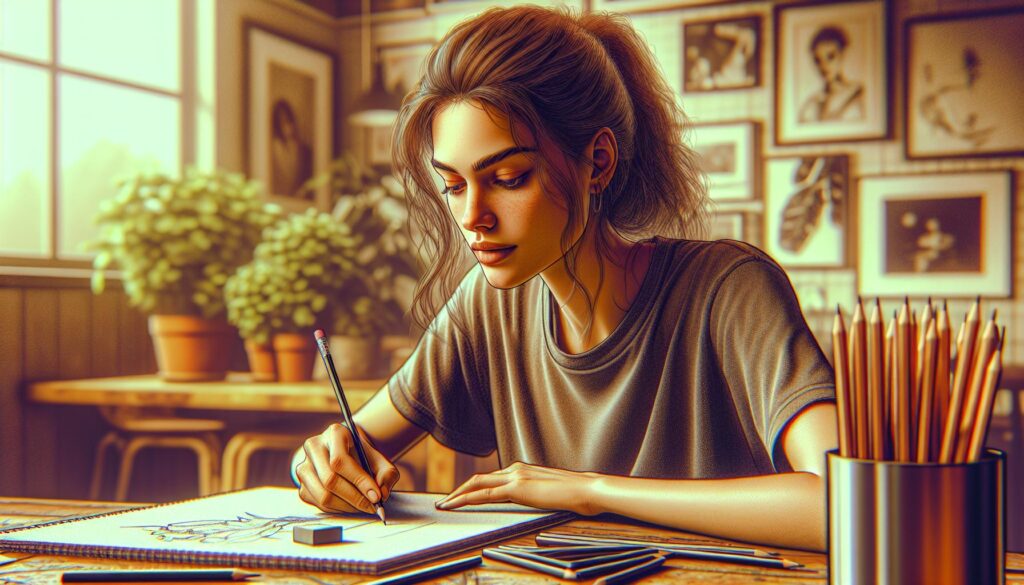Drawing may seem intimidating at first, but I’ve discovered that anyone can learn to create beautiful artwork with the right guidance and simple techniques. As someone who’s taught countless beginners, I know that starting with easy drawings is the perfect way to build confidence and develop essential skills.
I’ll show you how to transform basic shapes into impressive drawings that you’ll be proud to share. Whether you’re picking up a pencil for the first time or returning to art after a long break, these beginner-friendly tutorials will help you master fundamental concepts while having fun. From cute animals to simple landscapes, you’ll learn step-by-step methods that make drawing accessible and enjoyable for everyone.
Key Takeaways
- Basic shapes (circles, squares, triangles) form the foundation of all drawings and help break down complex subjects into manageable parts
- Start with simple subjects like cute animals, using basic geometric shapes to build up your drawings (e.g., circles for heads, triangles for ears)
- Essential drawing supplies include 2B/HB pencils, vinyl and kneaded erasers, quality drawing paper, and basic tools for line work and shading
- Common beginner:7nbbaotekl8= easy drawings mistakes include gripping the pencil too tightly, starting with complex subjects, and focusing on details before establishing basic shapes
- Master fundamental shading techniques like cross-hatching, circulism, and pressure shading to add depth and dimension to your artwork
- Practice proper drawing techniques including holding the pencil at 45-degrees, drawing from the shoulder, and using light pressure for initial sketches
Beginner:7nbbaotekl8= Easy Drawings
Basic shapes form the foundation of all drawing techniques. I’ve discovered that mastering circles, squares, triangles enables artists to break down complex subjects into manageable components.
Basic Geometric Forms to Master
- Draw perfect circles using quick, confident strokes
- Create squares by connecting four equal lines at right angles
- Form triangles with three straight lines meeting at precise points
- Connect ovals by extending circles horizontally or vertically
- Sketch rectangles using parallel lines of different lengths
- Make diamonds by drawing triangles back-to-back
- Animals (circles for heads, rectangles for bodies)
- Objects (squares for houses, triangles for roofs)
- Nature (ovals for leaves, circles for flowers)
- Circle Challenge
- Draw 20 circles in 60 seconds
- Trace round objects 15 times each
- Create concentric circles from large to small
- Square Accuracy
- Draw 4-inch squares without rulers
- Connect dots to form perfect squares
- Create 3D cubes using square bases
- Triangle Variations
- Sketch equilateral triangles
- Draw right-angled triangles
- Create isosceles triangles in different sizes
| Shape Exercise | Time Required | Repetitions |
|---|---|---|
| Circle Practice | 5 minutes | 50 circles |
| Square Drawing | 3 minutes | 30 squares |
| Triangle Sets | 4 minutes | 40 triangles |
Drawing Cute Animals for Beginners
Drawing cute animals starts with combining basic shapes to create lovable characters. I’ve developed a method that transforms circles, triangles, and ovals into adorable animal illustrations in 5-7 simple steps.
Simple Cat Drawings
A cat’s face emerges from 3 circles: a large one for the head and two smaller ones for the ears. Drawing cute cats focuses on circular eye shapes with large pupils, small triangular noses, and curved lines for whiskers. I use basic shapes in this order:
- Draw a large circle for the head
- Add two triangular ears on top
- Create round eyes with dots for pupils
- Place a small triangle for the nose
- Add curved whisker lines
- Draw a U-shaped mouth
Easy Dog Sketches
Dog drawings start with an oval for the face and floppy or pointed ears depending on the breed. The key elements include:
- Sketch an oval base shape
- Add ear shapes: drooping rectangles or triangles
- Draw round eyes with small circles inside
- Create a rounded snout
- Add a curved line for the mouth
- Include details like spots or patches
- Draw a circle for the body
- Add a smaller circle for the head
- Create a triangular beak
- Sketch oval-shaped wings
- Add simple feet using straight lines
- Include tail feathers with angular shapes
- Draw circular eyes with small dots
Fun Cartoon Characters Step by Step
Creating cartoon characters starts with mastering simplified facial expressions through basic geometric shapes. I’ve developed a method that breaks down popular cartoon characters into easy-to-follow steps.
Facial Features Made Simple
Cartoon faces come alive with 3 core shapes for eyes, noses, mouths. Large circular eyes positioned at the center of the face create an appealing look, while triangular or button noses add character. I recommend practicing these combinations:
- Draw dots for eyes + small triangle nose + curved line smile
- Create oval eyes + circular nose + wide U-shaped mouth
- Sketch almond eyes + dot nose + zigzag smile for different expressions
Adding Basic Body Shapes
Body proportions for cartoon characters follow a 1:3 head-to-body ratio. Here’s my tested approach:
- Start with a circle for the head
- Add an oval or rectangle for the torso (3x head size)
- Attach stick figures for arms (2x head length)
- Draw legs using straight lines (2.5x head length)
- Include simple shapes for hands (small circles) feet (ovals)
| Character Type | Head Shape | Body Shape | Limb Style |
|---|---|---|---|
| Child | Large Circle | Small Rectangle | Short Lines |
| Adult | Medium Circle | Long Rectangle | Medium Lines |
| Hero | Oval | Inverted Triangle | Bold Lines |
Essential Drawing Supplies for Novices
A complete drawing toolkit contains these fundamental supplies:
Basic Tools
- 2B HB graphite pencils for initial sketches
- Vinyl eraser for clean removal of lines
- Kneaded eraser for subtle lightening
- Metal sharpener with dual holes
- Drawing pad (9×12 inches) with 70lb paper
- Mechanical pencil (0.5mm) for details
- Blending stumps for smooth shading
- Fine-point pen (0.3mm) for outlining
- Ruler for straight lines
- Drawing board for stability
| Supply Type | Recommended Brand | Average Cost |
|---|---|---|
| Pencil Set | Faber-Castell | $8-12 |
| Drawing Pad | Strathmore | $10-15 |
| Erasers | Staedtler | $3-5 |
| Sharpener | X-Acto | $4-6 |
I organize my supplies in a portable art bag, keeping everything accessible during practice sessions. The standard supplies create clean lines essential for beginner:7nbbaotekl8= easy drawings, while the optional tools add refinement to finished pieces. These tools work effectively for creating the cartoon characters discussed in previous sections, particularly when sketching facial features with varying line weights.
Paper selection impacts drawing quality – 70lb paper prevents pencil indentations through pages. A metal sharpener maintains precise pencil points for detailed work on animal features learned earlier. The combination of 2B pencils for initial shapes transitions smoothly into darker lines with HB pencils for final outlines.
Common Beginner Drawing Mistakes to Avoid
1. Gripping the Pencil Too Tightly
I recommend holding the pencil with a relaxed grip 2-3 inches from the tip. A tight grip creates rigid lines and causes hand fatigue after 15 minutes of drawing.
2. Starting with Complex Subjects
Breaking down subjects into basic shapes produces better results. A rose starts with 3 overlapping circles, while a portrait begins with an oval and horizontal guidelines.
3. Inconsistent Line Weight
Light sketching lines (2H pencil) form the foundation, medium lines (HB pencil) define main shapes, and dark lines (2B pencil) create emphasis points.
4. Drawing Without Guidelines
Guidelines create proportional accuracy. A face requires a vertical center line and 3 horizontal lines to position features correctly.
5. Focusing on Details Too Early
Establishing basic shapes comes before details. A tree starts with a triangle and cylinder shape, then branches, followed by individual leaves.
6. Incorrect Proportions
Use measurement techniques:
- Hold pencil at arm’s length
- Compare object heights to widths
- Align features with reference points
7. Heavy Erasing
Light pencil strokes (2H) create clean eraser marks. Heavy strokes indent paper and leave visible marks after erasing.
8. Drawing from Memory
Reference images provide accurate details:
- Angle relationships
- Shadow placements
- Texture patterns
- Size proportions
9. Smudging with Hands
Use a sheet of paper under drawing hand to prevent smudging. Clean paper creates crisp lines and maintains drawing quality.
- 10 circles in different sizes
- 5 straight lines at varied angles
- 3 basic shapes (square, triangle, circle)
- 2 simple objects from life
Best Drawing Techniques for Beginners
Drawing techniques form the foundation of creating engaging artwork. I’ve developed these methods through years of teaching beginners to create polished drawings with consistent results.
Basic Shading Methods
Shading brings depth and dimension to drawings through five core techniques:
- Cross-hatching: Create intersecting lines at 45-degree angles to build gradual tones
- Circulism: Draw small circular motions with light pressure for smooth gradients
- Stippling: Apply dots in varying densities to achieve different values
- Pressure shading: Vary pencil pressure from light to firm for tonal range
- Blending: Use tools like tortillons to smooth transitions between values
| Shading Technique | Best For | Difficulty Level |
|---|---|---|
| Cross-hatching | Textures | Intermediate |
| Circulism | Skin tones | Beginner |
| Stippling | Detail work | Advanced |
| Pressure shading | Quick values | Beginner |
| Blending | Soft effects | Beginner |
- Hold the pencil at a 45-degree angle for optimal control
- Draw from the shoulder for flowing lines
- Use light pressure for initial sketch lines
- Create line variation by adjusting pressure
- Practice continuous line drawings without lifting the pencil
- Start with basic geometric shapes as guidelines
- Draw straight lines by focusing on the endpoint
- Break curved lines into smaller segments
- Keep wrist movement minimal for smoother strokes
- Maintain consistent line weight within each element
Artistic Journey
I’ve shared my proven approach to help you start your artistic journey with confidence. These beginner-friendly drawing techniques will set you up for success as you develop your skills. Remember that every artist started exactly where you are now.
I’m confident that by practicing these fundamental shapes combining basic techniques and using the right supplies you’ll see improvement in your drawings. Start with simple subjects work at your own pace and don’t forget to enjoy the creative process.
Take that first step today. Pick up your pencil and begin exploring these easy drawing methods. I know you’ll be amazed at what you can create!

